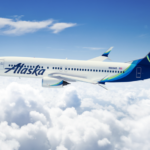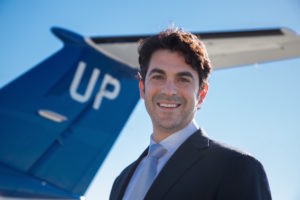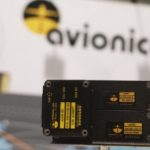
New Analytics, Antenna and Cable Technology at AIX 2019
Avionics manufacturers and aircraft connectivity service providers are responding to airlines’ demands for faster connection speeds, more flexible architectures and aircraft data analytics platforms at the 2019 Aircraft Interiors Expo (AIX) 2019 in Hamburg, Germany. Here are some of the newest connected aircraft technologies and components that made their public debut on the second day of AIX. Panasonic Unveils ‘Insights’ Data Analytics Panasonic unveiled the latest component of its NEXT platform: a cloud-based analytics solution that harvests data from onboard and third-party sources from a wide range of touchpoints, including entertainment, connectivity, social media, location and weather monitors. It analyzes this data to help airlines improve the onboard passenger experience, pre-emp maintenance needs and drive revenue. Airlines will also have access to seasonal and temporal trends data through Insights, with the ability to benchmark their performance against industry averages and KPIs. Insights will be accessible via a secure dashboard on mobile devices. It has two components: A Software-as-a-Service (SaaS) application and Consulting. The SaaS component offers the data and insights described above while the Consulting piece offers airlines tailored solutions for specifics challenges. Consulting will also release monthly trends reports based on Panasonic’s global data, available by monthly subscription. “Airlines today have access to more data points than ever before, and Panasonic’s Insights solution takes all the leg-work out of analyzing and leveraging that data,” said David Bartlett, chief technology officer of Panasonic Avionics Corporation. “By fully integrating Insights across every aspect of their passenger experience, airlines will be able to use the information it delivers to optimize their passenger experience and business performance,” he added. “It is solutions like this that will enable airlines to remain competitive in the saturated market place and continue to grow their market share.” Insights will be available in the second half of 2019, according to Panasonic. Viasat’s Second-Generation Hybrid Ku/Ka-band System Viasat has a new second-generation Ku-/Ka-band shipset, including a hybrid antenna and complimentary radome. The shipset will allow airlines to provide connectivity via today’s Ku- and Ka-band networks as well as prepare for the global ViaSat-3 constellation planned for launch in 2021 and 2022. “Hybrid antenna systems are not new to Viasat—we have nearly two decades of experience deploying and managing these systems,” said Don Buchman, vice president and general manager for commercial Aviation at Viasat. “Similar to the first generation, Viasat’s latest dual-band system promotes smooth transitions among multiple satellite beams across Ku- and Ka-band networks.” When flying on routes with the hybrid shipset installed, customers will have in-flight access to all Ka-band satellites currently participating in Viasat’s global network. When out of Ka-band coverage, service will switch to the Ku-band network. Once the Viasat-3 constellation is fully deployed — which the company estimates will happen in 2022 — global Ka-band coverage will be available. SmartSky Selects Gore’s Vapor-Sealed 7 Series Cable Assemblies SmartSky Networks selected Gore’s vapor-sealed 7-series for their new in-flight connectivity system that provides 4G LTE air-to-ground (ATG) connection in aircraft such as the Embraer ERJ-135 operated by JetSuiteX. The connectivity system has now received supplementary type certification for the ERJ-145. “Gore’s 7 Series is high performance and exceptionally reliable, enabling a real fit-and-forget installation to exceed our customers’ expectations now and for many years to come,” said Darren Emery, vice president for product support at SmartSky.
Viasat, China Satcom Bring IFC to Airlines Over China
Viasat and China Satellite Communications (China Satcom) entered into a strategic partnership to jointly provide In-Flight Connectivity (IFC) services within China for domestic and international airlines. Viasat and China Satcom will help enable Viasat’s global airline customers to have roaming connectivity when flying over China; provide IFC service to domestic flights within China; and enable Chinese airlines to roam onto Viasat’s global network. China Satcom is a licensed telecommunications service provider in China and also owns and operates a Ka-band spotbeam satellite system in China, which is the only Ka-band system currently available for IFC service in the country. Yet today, only about four percent of flights within China are connected. “Our agreement with China Satcom is a significant step towards realizing a seamless global community of high performance IFC. China Satcom is now the only satellite operator and licensed service provider in China with the bandwidth resources to deliver the in-flight experience our airline customers have come to expect and depend on,” said Don Buchman, vice president and general manager, Commercial Aviation, Viasat. “Our partnership is a natural way to extend state-of-the-art services specific to China Satcom’s fleet and the China domestic market, and create a global roaming alliance for our existing and new domestic and international customers and the rapidly growing Chinese global commercial airline fleet. We are honored to work with China Satcom in China to make IFC-at-scale a reality.”
AIX 2019: Airlines Seek a Connected Aircraft Digital Sweet Spot

In January, the Lufthansa Group and the Lufthansa Innovation Hub established a new research alliance with Hopper focused on the subject of artificial intelligence. That was their third technology-related investment within a year, following investments in the startups Fleet Logistics and cargo.one. Photo: Lufthansa Group

EASA Proposes New Aircraft Cybersecurity Certification Amendments
 The European Aviation Safety Agency (EASA) is proposing new cybersecurity amendments to the way aircraft electronic networks and systems are certified.
Under the new amendments, manufacturers and operators seeking certification of new aircraft systems and networks or modifications to existing ones will be required to address threats that can lead to unauthorized access and disruption of electronic information or electronic aircraft system interfaces. EASA is proposing the new amendments to address the growing presence of connectivity within modern aircraft network designs.
“Since aircraft systems are increasingly connected, and thus potentially vulnerable to security threats, EASA needs to consider the state-of-the-art means of protection against these threats when certifying new products or parts,” the agency said in the NPA.
EASA identified seven different certification specifications areas, including technical regulatory requirements for business jets, commercial airliners and rotorcraft. Amendments were developed based on recommendations provided by an Aviation Rulemaking Advisory Committee (ARAC) that was tasked by the FAA with standardizing the way aircraft systems are protected from emerging cyber threats. The amendments will also introduce more harmonization between EASA and FAA regulations.
As more satellite and air to ground-based connectivity has been introduced onto aircraft over the last decade, the industry has relied upon the separation of aircraft networks into three different domains: aircraft control, airline information and passenger information domains.
EASA’s proposed amendments focus solely on protecting the aircraft control domain, which features safety-critical flight controls used by pilots. As aircraft system designs evolve from point-to-point data bus communications to standardized protocols connected by switched Ethernet, they are increasingly susceptible to new cyber threats.
“These interconnections are susceptible to new threats, which may potentially have catastrophic effects on the safety of air transport. Those threats are caused by unauthorized electronic interaction that can be triggered by human action either intentionally or unintentionally,” the agency said.
The proposed amendments come as cyber attacks on airline and aircraft networks are increasingly occurring. As an example, in October 2018, Cathay Pacific reported the largest data breach ever suffered by a commercial airline when a hacker accessed information about 9.4 million of its customers. Alaska Airlines was also at the center of a major attack in 2017 when it merged with Virgin America.
Researchers with cybersecurity firm IOACTIVE also demonstrated their ability in late 2017 to hack into a live commercial aircraft satellite communications modem. EASA made it clear within the proposed amendments though that it is only concerned with threats to the safe operation of aircraft or continued airworthiness of systems or parts. Those would not include the type of attack demonstrated by IOACTIVE, or the data breach suffered by Cathay.
EASA is seeking industry comments on the new amendments through May 22, 2019, and expects to make a decision on implementing the new rules by the third quarter.
The European Aviation Safety Agency (EASA) is proposing new cybersecurity amendments to the way aircraft electronic networks and systems are certified.
Under the new amendments, manufacturers and operators seeking certification of new aircraft systems and networks or modifications to existing ones will be required to address threats that can lead to unauthorized access and disruption of electronic information or electronic aircraft system interfaces. EASA is proposing the new amendments to address the growing presence of connectivity within modern aircraft network designs.
“Since aircraft systems are increasingly connected, and thus potentially vulnerable to security threats, EASA needs to consider the state-of-the-art means of protection against these threats when certifying new products or parts,” the agency said in the NPA.
EASA identified seven different certification specifications areas, including technical regulatory requirements for business jets, commercial airliners and rotorcraft. Amendments were developed based on recommendations provided by an Aviation Rulemaking Advisory Committee (ARAC) that was tasked by the FAA with standardizing the way aircraft systems are protected from emerging cyber threats. The amendments will also introduce more harmonization between EASA and FAA regulations.
As more satellite and air to ground-based connectivity has been introduced onto aircraft over the last decade, the industry has relied upon the separation of aircraft networks into three different domains: aircraft control, airline information and passenger information domains.
EASA’s proposed amendments focus solely on protecting the aircraft control domain, which features safety-critical flight controls used by pilots. As aircraft system designs evolve from point-to-point data bus communications to standardized protocols connected by switched Ethernet, they are increasingly susceptible to new cyber threats.
“These interconnections are susceptible to new threats, which may potentially have catastrophic effects on the safety of air transport. Those threats are caused by unauthorized electronic interaction that can be triggered by human action either intentionally or unintentionally,” the agency said.
The proposed amendments come as cyber attacks on airline and aircraft networks are increasingly occurring. As an example, in October 2018, Cathay Pacific reported the largest data breach ever suffered by a commercial airline when a hacker accessed information about 9.4 million of its customers. Alaska Airlines was also at the center of a major attack in 2017 when it merged with Virgin America.
Researchers with cybersecurity firm IOACTIVE also demonstrated their ability in late 2017 to hack into a live commercial aircraft satellite communications modem. EASA made it clear within the proposed amendments though that it is only concerned with threats to the safe operation of aircraft or continued airworthiness of systems or parts. Those would not include the type of attack demonstrated by IOACTIVE, or the data breach suffered by Cathay.
EASA is seeking industry comments on the new amendments through May 22, 2019, and expects to make a decision on implementing the new rules by the third quarter.

Air Esurfing Named Honeywell JetWave Sole Distributor in China
AirMedia Group revealed that one of its subsidiaries, Air Esurfing (ARE), has been selected as the sole distributor of Honeywell‘s next-generation JetWave satellite communications hardware in China. This gives Chinese airlines access to a solution that aims to provide high-speed, in-flight Wi-Fi service. According to the release, Honeywell’s JetWave satellite communications hardware aims to provide high-speed in-flight Wi-Fi service worldwide by establishing Ka-band communication links with the Global Xpress Network of the International Maritime Satellite Organization (Inmarsat Aviation) and satellite ChinaSat 16 and ChinaSat 18. “China plays a significant role in our global growth and we are committed to working with local partners to help advance the country’s aviation industry,” said Honeywell Aerospace President of Asia Pacific Steven Lien. “This exciting cooperation with ARE gives Chinese airlines a competitive edge in a globalized market – providing them with hardware and connectivity that delivers in-flight Wi-Fi with in-office speed.”
Alaska Airlines Adds Gogo 2Ku IFC
Gogo and long-time partner, Alaska Airlines, launched Gogo 2Ku high-speed connectivity and Gogo Vision wireless In Flight Entertainment (IFE) on an A321neo featuring the airline’s redesigned cabin interior. Alaska will have satellite Wi-Fi powered by 2Ku available to guests on most of its Boeing and Airbus mainline fleet by the end of 2020. Gogo 2Ku is an In Flight Connectivity (IFC) solution and delivers an internet experience comparable to what guests have on the ground, including the ability to stream video from popular streaming video services. 2Ku also has global coverage, which means guests onboard Alaska aircraft will have service nearly everywhere they fly — even over the ocean to Hawaii, where connectivity was not previously available. “Gogo 2Ku is a key feature of the seamless digital experience created by Alaska as part of its integration with Virgin America,” said Gogo Commercial Aviation President John Wade. “We are proud to be part of this transformation as two great airlines come together.”
StandardAero Awarded SmartSky STC for Embraer Jets
StandardAero achieved the first supplemental type certificate (STC) for SmartSky’s in-flight connectivity system for an Embraer model aircraft type. Under the new STC, SmartSky’s system can be installed on the Embraer ERJ135/140/145 regional airliners and Legacy 600/650 business jets. The STC was awarded to StandardAero under its organization designation authorization from the FAA. The company is also working on additional SmartSky STCs for Embraer Legacy 450s and 500s, as well as Dassault Falcon 7X, 8X and 50EX models. “This allows a significant section of the aviation community to access SmartSky’s affordable and secure inflight connectivity solution,” says StandardAero Certification Services Director John Miedwig. SmartSky recently announced JetSuiteX as the official launch customer of its next-generation air to ground in-flight connectivity network. The company is anticipating full coverage across U.S. airspace by the end of 2019. Under the new STC, SmartSky’s system can be installed on the Embraer ERJ135/140/145 regional airliners and Legacy 600/650 business jets. The STC was awarded to StandardAero under its organization designation authorization from the FAA. The company is also working on additional SmartSky STCs for Embraer Legacy 450s and 500s, as well as Dassault Falcon 7X, 8X and 50EX models. “This allows a significant section of the aviation community to access SmartSky’s affordable and secure inflight connectivity solution,” says StandardAero Certification Services Director John Miedwig. SmartSky recently announced JetSuiteX as the official launch customer of its next-generation air to ground in-flight connectivity network. The company is anticipating full coverage across U.S. airspace by the end of 2019.
#GCAPODCAST Ep. 8: Wheels Up CSO Miles Rogers

Miles Rogers is the chief strategy officer of Wheels Up. Photo: Wheels Up.
On this episode, we talked to Wheels Up Chief Strategy Officer Miles Rogers about in-flight calling, web surfing and how his company is becoming the Uber of private air travel.
Previously, Rogers served senior vice president at Marquis Jet and NetJets from 2004-2014. Since joining Wheels Up in 2014, he has played an integral role in the marketing, branding, and business development of Wheels Up working with numerous Fortune 500 companies, media outlets and brand ambassadors including Serena Williams, Wayne Gretzky, Russell Wilson, Sidney Crosby among others.
Check out the new episode in the link below, or download it from Apple Podcasts.

Addvalue, Avionica to Develop New SwiftBroadband Aircraft Terminals












